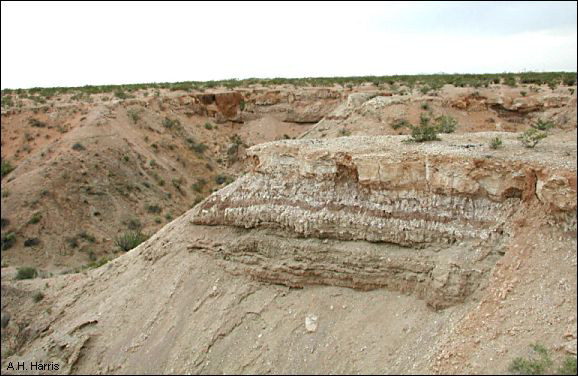

Desert badlands show shades of brown, red, sometimes even green. And in much of the region, whitish layers form prominent bands. These are deposits of calcium carbonate, known in this context as caliche. Close inspection reveals that they are formed by deposition of the caliche as cement between particles of sediments.
How did these caliche beds form? Certainly not in oceans like the older
limestones so common here. No, these are dryland deposits. Waters falling on the
alkaline areas of the region dissolve small amounts of calcium. In wet times, such
mineral-charged waters are flushed away in ground or surface waters. In drier regimes,
though, ground penetration is limited, and water only makes it a few feet
down—the minerals build up and impede water that might sink lower. The caliche
layer is in place and continues to grow until new sediments bury the ground surface
deep enough that water no longer gets to the layer. Revealing the past, most caliches
record stable ground surfaces, lasting perhaps hundreds or thousands of years.

Contributor: Arthur H. Harris, Laboratory for Environmental Biology, Centennial Museum, University of Texas at El Paso.
Desert Diary is a joint production of the Centennial Museum and KTEP National Public Radio at the University of Texas at El Paso.

Caliche forms the uppermost layer—the "caprock"—of the sediments except for wind-blown sand and lag deposits left behind where wind has stripped away the finer particles. Edge of La Mesa Surface, west of the Rio Grande Valley. Photograph by A.H. Harris.